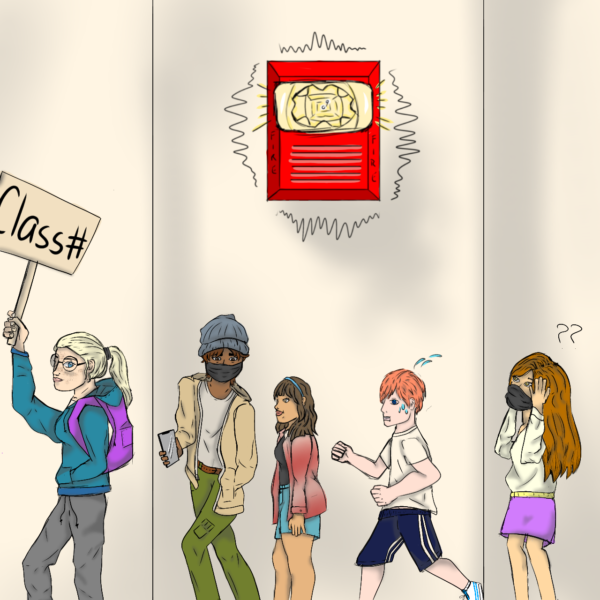

On Aug. 31 at approximately 9:40 a.m., the fire alarm rang throughout campus. The water pressure sank dramatically, meaning that in the case of a fire, the sprinklerswould not work. This set off the fire suppression system, triggering the alarm throughout the school.
“It takes us a few minutes to figure out what exactly is going on, and then we have to wait for the San Mateo fire department to come to us,” said Principal Valerie Arbizu. “We’re not allowed to silence our own alarms even if we know that there isn’t a fire.”
Teachers in the San Mateo Union High School District attend professional development to stay informed about how to act in the event of an emergency. Certified staff also play a role in executing and teaching protocols in the event of an emergency.
Since 2014, ‘The Big 5’ poster provides immediate procedures for schools to follow in a variety of emergency situations and is shared across 23 school districts. Students learn how to react through drills. In an earthquake, drop, cover and hold on. In the event of an intruder, the campus is secured and doors are barricaded. In the event of a fire, students are to evacuate as quickly and safely as possible. Despite the specific protocols, ‘The Big 5’ emphasizes the importance of thinking on one’s feet and taking immediate action during an emergency.
When alarms sound, all classes are expected to follow an evacuation protocol, which involves students leaving their classrooms and lining up by class on the football field.
Substitute teachers, who don’t receive the same training as full-time staff, also faced challenges
Social studies teacher Jayson Estassi led his class out of the classroom and to the football field as protocol informs. When the class arrived at the gate on the east side of campus, they were locked out along with several other classes that followed the same route to the field. The class took a detour back behind the field to enter through the open gate. Had there been a real fire, this detour could have been dangerous.
“Mr. Estassi was calm and [made] sure we were not panicking,” said junior Julia Santos. “After we got in, we had to find our class line which was all the way at the end of the field.”
Substitute teachers, who don’t receive the same training as full-time staff, also faced challenges. A substitute filling in for teacher Steve Henderson’s freshman Ethnic Studies class did not direct the students out of the classroom and made the decision to stay in while others evacuated the premises.
“We sat there for about five minutes,” said freshman Aanika Das. “We decided as a class it was probably best to leave, so we walked out.”
This worried students, as in the event of a real fire, it would be vital to evacuate quickly.
“If there was an actual fire, we would have wanted a substitute to react right away,” Das said. “We all packed our bags and we took our time. I feel like we wouldn’t do that in a real fire, and [would] want [substitutes] to be more responsive [even during drills].”
“We decided as a class it was probably best to leave, so we walked out”
After each drill or emergency, staff and faculty report to the administration on ways to improve and help the procedures run more smoothly.
“The teachers [send an email with feedback],” said Campus Safety Specialist Hosea Patton. “So the administration team goes right to work on tightening up and getting [the kinks] right.”
With many drills planned for the school year and ‘The Big 5’ poster in every classroom, the staffulty works to make Aragon safe for everyone.



